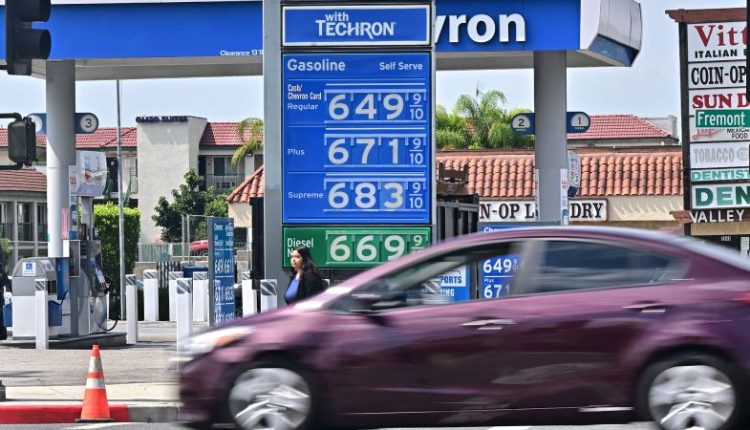Pain at the pump is returning across the United States, especially on the West Coast.
In California, gas prices are rapidly approaching $6 a gallon. According to AAA, the state average has spiked by 30 cents in the past week alone, to $5.76 gallon.
The move has been even more dramatic in the Los Angeles-Long Beach metro area, where gas prices hit $6.03 a gallon on Tuesday, up 47 cents in a week.
But it’s not just California drivers experiencing sticker shock. Drivers in 11 states on average now face gas at $4 a gallon, including $5 or higher in Washington and Nevada.
Nationally, gas prices remain well below the record of $5.02 set last June. Still, US gas prices climbed this week to $3.88 a gallon, the highest level of the entire year, according to AAA.
And oil prices — the main driver of retail pump prices — continue to set new highs in large part because that’s what Saudi Arabia and Russia want.
Boosted by those two nations’ aggressive supply cuts, US oil prices climbed to as high as $93.74 a barrel on Tuesday. That’s a fresh 10-month high. Brent crude, the international benchmark, is getting closer to $100.
The jump in gasoline prices is painful to consumers, especially lower-income families. It’s a highly visible reminder of the current cost of living.
And this recent rise in gas prices is causing headaches for some in Washington.
Pain at the pump will only add to President Joe Biden’s political problems. Voters have a long history of blaming whoever is sitting in the Oval Office, fair or not.
For Federal Reserve Chair Jerome Powell and his colleagues, the recent rise in energy prices complicates their mission to tame inflation. However, Fed watchers say Powell is unlikely to overreact to near-$4 gas.
The good news is that energy prices are not close to levels where they would pose an immediate risk to the US economy.
“History says we are nowhere near having to worry about rising oil prices tipping the US economy into a recession,” Nicholas Colas, co-founder of DataTrek Research, wrote in a note on Tuesday.
Colas said history shows oil prices must double in a year or less before a recession is inevitable. That would mean oil prices would need to spike all the way to $140, a level that not even the biggest oil bulls are calling for.
“We would need much higher oil and gasoline prices for the consumer to crack,” said Joe Brusuelas, chief US economist at RSM.
Thankfully, some energy veterans think gas prices may be at or near a peak.
Andy Lipow, president of consulting firm Lipow Oil Associates, expects prices east of the Rockies to drop by five to 10 cents a gallon in the coming days. He pointed to sinking gasoline futures, “adequate” inventories of gasoline, cooling demand and the winding down of hurricane season.
Even California gas prices are “peaking” and should “start to moderate” as imported gasoline cargoes arrive, Lipow said.
Lipow mostly blamed the recent price spike in California and neighboring states on a series of refinery outages.
Of course, much depends on what happens next in the turbulent oil market. And that could be determined by OPEC+.
If Saudi Arabia and Russia don’t unwind their supply cuts by next year, Brent crude could hit $107 a barrel, Goldman Sachs recently said.
Citigroup told clients on Monday there is a chance that geopolitics pushes oil above $100 a barrel “for a bit.” However, the bank argued that “$90 prices look unsustainable” and predicted US oil will drop below $70 a barrel by the second quarter.
All of this uncertainty doesn’t make life any easier for Powell and the Fed.
The rise in gas prices was the main reason headline inflation heated up in August. The same thing could happen in September.
“It’s difficult for a central bank when oil prices rise. It’s a nagging reminder that prices are unstable,” said Vincent Reinhart, a former Fed economist who now serves as chief economist at Dreyfus and Mellon. “And day to day, oil prices are nowhere near in control of the Fed.”
Still, Fed watchers don’t expect a dramatic impact on Fed policy unless prices go much higher. That’s because core inflation — which excludes food and energy — continues to cool. And it takes time for high energy prices to feed into core inflation.
“The Fed will acknowledge this rise in energy prices but largely look through it,” said RSM’s Brusuelas. “$100 is just another number for the Fed.”
Wall Street is very confident the Fed won’t raise interest rates at Wednesday’s meeting. The futures market is pricing in a 99% chance of no change in rates at this meeting.
But Reinhart thinks Fed officials on Wednesday will “pencil in” one more quarter-point rate hike through the end of the year. “Oil prices just make it hard to do otherwise,” he said.
Some argue that higher energy prices could help the Fed tame inflation.
Morgan Stanley economists found in a recent analysis that energy price shocks have just a “small” impact on core inflation but tend to take a “sizable bite out of” consumer spending.
The bank said that for the Fed, the recent rally in oil prices “could be a blessing in disguise.”
“That could absolutely be the case,” said Kristina Hooper, chief global market strategist at Invesco. “Higher gas prices would help dampen consumer spending and that’s what the Fed needs — the consumer has been driving this economy and keeping it strong.”
Read the full article here

